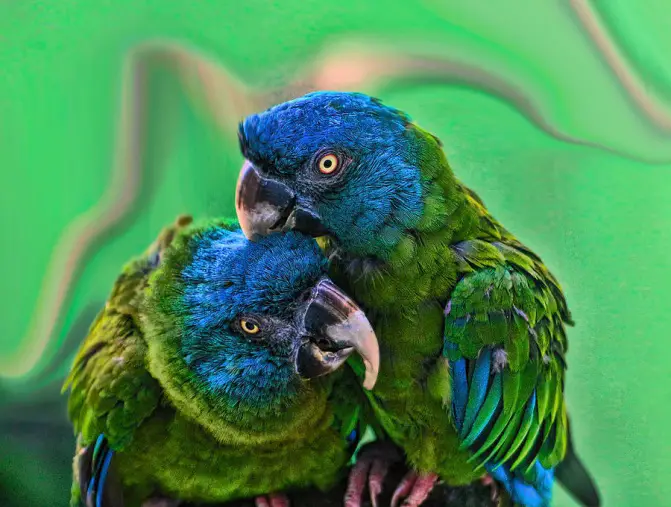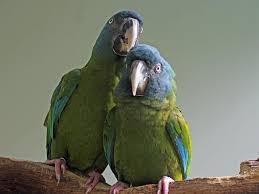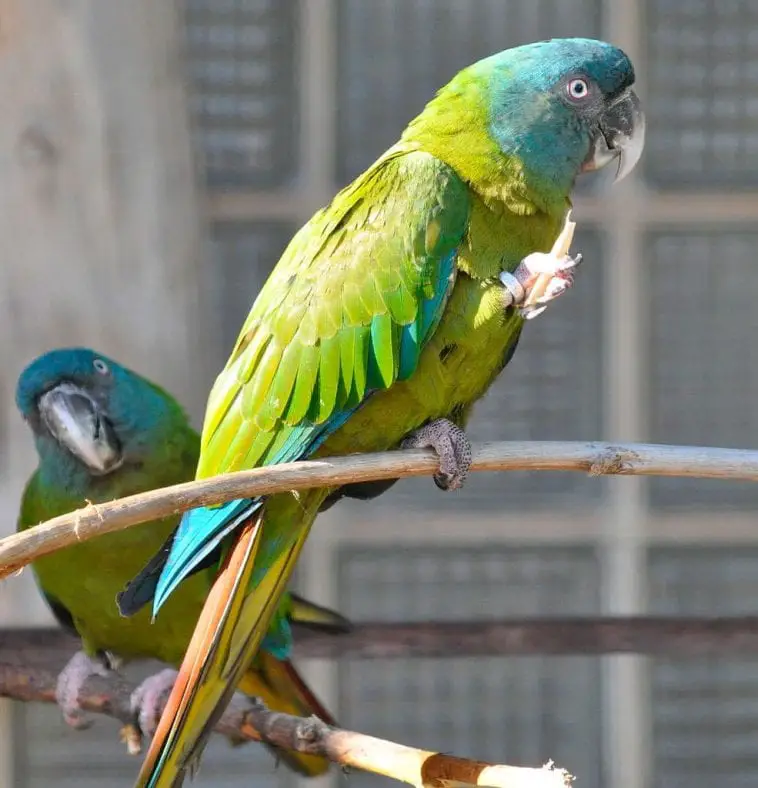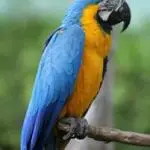Scientific Facts
| Common Name: | Blue-headed macaw, Coulon’s macaw |
| Scientific Name: | Primolius couloni |
| Life Span: | 30 to 35 years in the wild, 50+ years in captivity |
| Size: | 40 to 41 cm size, 207 to 294 grams weight |
| Habitat: | Humid low-land forests, near rivers, and cleared areas |
| Country of Origin: | Eastern Peru |
Physical Description
The blue-headed macaw, also called Coulon’s macaw, is a species of bird native to the eastern parts of Peru except in the North, north-western Bolivia and western Brazil. It is a medium-sized bird that can measure 16 inches. It belongs to the family of smaller macaws or mini-macaws. It has a long and pointed tail with a large and heavy bill. The name Coulon’s macaw was derived from Paul Louis Coulon, a Swiss naturalist.
The blue-headed macaw is about 16 inches long with generally green plumage with a tinge of olive, especially in its lower body. The head and the flight feathers are blue. This bird’s upper tail has a maroon-colored base, a green center, and blue tips.
The macaw’s undertail and under its wing are greenish-yellow, which is common in other smaller macaws. It has a medium-sized bill with a grey horn and a black base. The extent of its coloring may vary, but the upper mandible in adults is blue.
The blue-headed macaw has a white iris with a narrow, maroon eye-ring. Compared to other macaws, the skin on the face and lores are dark grey. The bird’s legs are dull pink.
Juvenile blue-headed macaws look very similar to adults, but most have a black bill, grey legs, darker irises, and the lores and facial skin are white.
The blue-headed macaw has been placed under the genus Propyrrhura in many years. This is incorrect according to ICZN rules, and the new species is now called Primolius couloni.
Blue-headed macaw status

The blue-headed macaw was a common species of macaws, but according to a review in 2006 conducted by BirdLife International, this was rare, and the population is slowly decreasing. In 2006, the population of blue-headed macaws was 1000 to 2500 in the wild.
Due to this review, the species has been listed as endangered in the 2007 IUCN Red List. The range of this species is still unknown, but according to Tobias & Brightsmith, previous estimates were considered too low, and this macaw has around 9200 to 46000 mature birds. Which is why there are suggestions that this bid should be included in the “vulnerable” category.
There are many reasons why the blue-headed macaw is included in the vulnerable list of IUCN Red List. One of these is the capture of birds for the wild pet trade. As of 2007 August, the International Species Information System has listed 26 birds found in zoos that are far from their native lands. Loro Parque has 35 + macaws. It was also reported by CITES that there are 50 illegally-held individuals who were seized around the world.
Lifespan

The blue-headed macaw can live from 30 to 35 years in the wild. In captivity, these lovely birds can live up to 50 years or more. These birds can live longer in captivity because they are cared for by their owners and are kept away from possible predators. With careful captive breeding, some breeders were able to breed healthy and happy baby blue-headed macaws.
Natural Habitat
Blue-headed macaws are native to southwestern Amazonia near the Andean foothills. This colorful bird occurs in eastern parts of Peru north to the upper areas in Huallaga Valley and east to the far west of Brazil. It also occurs in the south to Apurimac located in the southern-central area of Peru and east to west and north of Bolivia. These species are also easy to spot near the foothills of Cusco, Peru.
You’ll also find blue-headed macaws near the lowland forests near rivers as well as settled and cleared areas and swamps.
Perception and Communication
The calls or vocalizations of the blue-headed macaw is very different from the common bird. These birds are quiet with purring sounds when in flight and has soft nasal, rasping sounds. This may squeak and shriek as well but are not as loud as the blue-winged macaws. In captivity, these birds are medium-noisy and may try to mimic normal human noises and noises made by their surroundings.
Behavior

Blue-headed macaws are social birds. In the wild, these can be seen perched on trees with up to 50 individuals. And because it’s social, you must consider housing this with at least two to three birds to mimic its natural behavior in the wild. During the breeding season, blue-headed macaws are seen in pairs, but when not breeding, maybe in family groups composed of 4 or more birds. These birds usually converge in their favorite foraging spots in the forest or near rivers.
There is little information about this bird’s reproductive behavior in the wild. All is known is that it can make nests in bamboo and a tree. In captivity, the reproductive cycle of this bird is annual, with a clutch composed of 2 to 4 eggs.
Food and Diet
Blue-headed macaws are herbivores with their natural diet composed of seeds, fruits, nuts, and various green food. Some experts say that this bird may also eat insects, especially when these are still raising their young.
This macaw will also eat mineral-rich clay which is needed by the birds for protection against toxins which may be present in their diets
In captivity, the blue-headed macaw eats high-quality, commercially-prepared seed mixes with sunflower, oats, safflower, millets, and hemp seeds. Some growers feed their pets with fresh fruits, dried berries, vegetables, pine nuts, and green food.
Captive macaws will also require mineral supplements, especially before and after the breeding season. The most important nutrient is calcium for bone health and egg health. Parents need soft food as they raise their chicks. Meanwhile, some pet owners feed their macaws “super-seeds,” which are hemp seeds. These seeds have complete amino-acids, omega 3 and 6 fatty acids and trace minerals. Hemp seeds also contain high amounts of protein, which is important for good health and proper development.
Environment and Housing
Blue-Headed Macaws can grow as much as 16 inches in size; therefore, it’s best to keep it in a large cage or enclosure. Pick a spacious cage made of metal with a large so you can take the bird in and out its home with ease. The door must be secured with a lock, and this must be closed at all times.
This bird species need sturdy branches where it can perch. Choose natural plants to serve as places where they can stay or sleep. As much as possible, select trees that are common from its natural environment. Use natural vines where it can stay and swing on.
The Blue-Headed Macaw will also need a water basin and a container for its food. The container should have a wide mouth so that the bird can easily eat its food. You can place the cage on top of a sturdy surface like a large table, or you can use a cage with a stand. But no matter what, the cage must be away from direct sunlight and rain.
And if you’re considering getting two or more blue-headed macaws, use a large cage or enclosure. You may also have one custom-built. The cage may have a bedding of coconut husks or bark or wood shavings. This will absorb urine and are easy to remove when maintaining the cage. You may also use old newspapers, paper towels, or brown paper as bedding.
When cleaning bird cages, remove the bird from the cage and let it stay in a secure area; you may tie its feet on a tree branch or use a separate cage to house it for the meantime.
Hose the cage down, remove food and water containers, clean these separately. Use a natural cleaning product with disinfectant properties to remove dirt and smell. Also, if you’re using natural trees and plants inside the cage, remove felled or dry leaves, and make sure to care for the tree or plant as well.
Health and Common Issues
The Blue-Headed Macaw is a healthy and hardy breed but may also suffer from common health issues.
- Avian polyomavirus in birds
Avian polyomavirus in birds is an infectious disease that occurs in mammals and birds. This is a deadly disease that may affect young birds. This could be passed on to other birds through droppings and touching infected birds. Common symptoms of avian polyomavirus are the swollen abdomen, weight loss, poor appetite, vomiting, diarrhea, and dehydration. To prevent this, have your pet vaccinated against avian polyomavirus. You should have it checked right away because it can be spread to humans.
- Pacheco’s disease in birds
Pacheco’s disease is a fatal viral disease caused by a type of herpes virus. The infected bird may spread this disease through contact with infected droppings and nasal discharge. The virus may be dormant in a bird and activated when it is in stress.
Some stressful situations include moving, the death of a mate, and breeding. Symptoms of Pacheco’s disease include tremors, sinusitis, lethargy, anorexia, green-colored droppings, and death. You can prevent the spread of Pacheco’s disease, placing suspected birds in quarantine. This cannot be transferred to humans.
- Giardia in birds
This is a parasitic infection that may be passed on from one infected bird to another through cysts, which are abundant in the bird’s feces. Usually, the cause is unclean water supply. Symptoms include diarrhea, weight loss, dry and itchy skin, depression, and constipation. Take your bird to the vet as soon as you spot these symptoms. Giardia could be passed to humans if their water supply is also the same as the contaminated water supply of birds.
- Bird fever or psittacosis in birds
Bird fever is an infectious disease common in most species of birds. This is spread through contact with the droppings of infected birds. Common symptoms of bird fever are difficulty in breathing, watery and green droppings, discharge from the eyes and nose, lack of appetite, and lethargy. Bird fever must be treated right away, and since this is contagious to humans, pet owners should wear proper protective equipment when feeding their pets or cleaning their cages.
- Malnutrition
Birds with an imbalanced diet or don’t get nutrients from their diet could suffer from malnutrition. Any of the illnesses mentioned here may also contribute to malnutrition. Signs of malnutrition are feather stress bars and dark feather colors.
To avoid malnutrition, make sure that your bird is getting enough sunlight, especially when their cage is placed indoors. If you cannot move the cage or climate permits you from placing the cage outdoors, use artificial birdcage lighting.
Always be very careful in changing the bird’s diet. Usually, birds will refuse to eat new food and may starve themselves. Take your bird to a vet to examine it for malnutrition after a change in diet.
- Other bird symptoms
Aside from the five common health conditions, be very mindful of any of the following strange appearance or stance such as excessive plucking of feathers, trembling, walking in circles, poor balance, hanging using its beak, changes in behavior or attitude and other physical changes.
Any change in its droppings, breathing, eating, head appearance and shape, feathers, legs, and feet should be reported immediately.
Preventive Care
A Blue-Headed Macaw must undergo a complete physical examination about once every 6 to 12 months. Visit an avian veterinarian for proper care. He is an expert when it comes to dealing with bird conditions and illnesses. If you have any concerns about the health of your bird, don’t hesitate to ask. If an avian vet is not available in your area, consult a general vet, and ask for any recommendation.
Your pet must go through annual fecal examination for possible yeast, parasites, and bacteria infestation. Your vet may recommend vaccination for polyomavirus and routine blood testing to make sure he’s negative for these health conditions.
Birds need to have some nail and wing trimming, and only an avian vet can help get these done with ease. As a bird owner, you are responsible for your pet’s complete care. First, clean your bird’s cage regularly. Remove droppings and thoroughly wash the cage with a safe cleaning product. Don’t forget to clean the feeding and drinking dishes and all the bird’s toys and cage furniture. Doing these will help prevent the spread of illnesses and many health conditions.
Availability – Where to Get One?
African Blue-Headed Macaws are usually available for sale from a breeder, or an avian pet store. You can purchase these from an online pet shop, as well. The price for a Blue-Headed Macaw online is from $1000 to $1500 depending on the gender, age, and overall appearance of the bird. This is one of the most expensive birds and doesn’t forget to consider shipping and delivery costs.
Blue-Headed Macaws and other exotic birds are also available for adoption from bird adoption or rescue organizations. These institutions help birds find new and loving families and homes.
How to Care for a Blue-Headed Macaw?
Remember that Blue-Headed Macaws have distinct physiology with some unique requirements. Aside from medical attention, it is also important to be willing to commit to four hours every day for cage maintenance, feeding, and interaction. You must never overlook caring for your pet macaw because doing so will help maintain your pet’s good mental and physical condition.
Place your pet in an appropriately sized cage that’s comfortable and safe. The cage must be big enough to allow your bird to spread his wings without contacting the cage bars. When housing two or more birds use a very large cage or better yet, have a cage custom-made. Place natural branch perches and some toys like paper-stuffed toys, woven toys, and other similar items.
Remember to hold your pet regularly. This will create a close bond between you and your pet. Learn how to handle it with care and perch it on your arm and shoulders. Use a glove to protect your hands from the bird’s sharp claws. Also, teach other people in your home how to correctly handle your pet bird.
And when it comes to feeding your pet, give it appropriate bird food. You can use commercially-prepared food. For fruits and vegetables, organic produce is always the best. Have a fixed feeding schedule, and don’t feed too much to avoid obesity and other weight-related illnesses. Always maintain a bowl with clean water inside the cage and change this twice daily.
FAQ Section
Are blue-headed macaws endangered species?
No, the blue-headed macaws are not endangered but are considered vulnerable by the IUCN Red List. The sale of the blue-headed macaw should be discouraged to stop the illegal pet trade.
Can blue-headed macaws talk?
No, the blue-headed macaws cannot talk but can shriek and squeak instead. These birds are also noisy but not as noisy as other macaws and parrots.
Can blue-headed macaws eat fruits?
Yes, in fact, fruits are part of the blue-headed macaws’ staple diet. Local south American fruits are a part of their diet as well as vegetables, nuts, and sometimes insects.
How do blue-headed macaws communicate?
These birds communicate with each other by shrieking and squeaking by moving their heads and wings and other natural movements. These birds love music and may nod its head and move it side by side to show its appreciation for music.
Can you keep only one blue-headed macaw?
Yes, you can keep or take care of only one macaw, but don’t forget that this bird is highly social and may prefer to have a cage mate rather than be alone.
How do you clean blue-headed macaws?
You can shower your pet by using a spray bottle or with a handy shower head. Don’ use soap or shampoo because the ingredients of these cleaning products may be harmful to your plants.
Will blue-headed macaws pluck their feathers?
Yes, blue-headed macaws may pluck their feathers, especially when your pet is in too much stress. The most common reasons for stress are moving or transferring its cage, the death of a cage mate or mate, sickness, malnutrition, and exposure to temperature extremes.
How many eggs will a female blue-headed macaw lay?
A blue-headed macaw may lay a clutch with 2 to 4 eggs. This depends on the health of the mother bird and other factors.
Will a female blue-headed macaw take care of its young?
Yes, female blue-headed macaws can take care of its young. It can fly and look for food to feed her babies, sometimes search far and wide for their food.
Will blue-headed macaws recognize their owners?
Yes, some pet owners say that their pet blue-headed macaw can recognize them, The birds may become restless and could shriek loudly when their owner is near.
Can you teach a blue-headed macaw how to talk?
Some pet owners agree that they can teach their pet blue-headed macaw how to talk a few words by regularly talking to them and by playing music or TV near their cages. But this is impossible, according to some pet owners, because this is a very quiet bird.
Can blue-headed macaws fly high?
Yes, blue-headed macaws can be quite a flier and can even fly extensively to look for food and to look for nesting sites.
Do blue-headed macaws have distinct colors?
No, only one color pattern exists, and this is having a green body, blue head and wings, and long green tail. There are no other color combinations.
Is a blue-headed macaw a good first-time pet?
Yes, this macaw can be a good first-time pet because these are easy to look after and won’t need extra care or special food.
How to take your blue-headed macaw to the vet?
You must have a special small cage with a handle to easily take your pet to the vet. Bring gloves, pet food, water, and treats in a bag if you need to take your pet to the vet.



